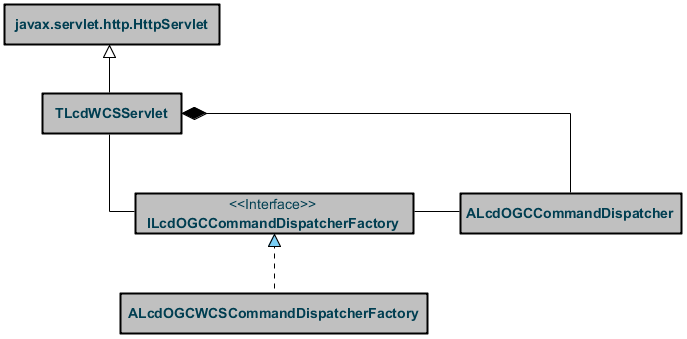Overview
This article describes the LuciadLightspeed WCS Server API, which provides its users with an easy framework for setting up a Web Coverage Service. The WCS is implemented as a Java servlet with all required request handling facilities, and can serve coverages in GeoTIFF format out of the box.
The main task that remains for the user of the API is to implement the server-side data store for the WCS. The user may choose to read geographic data from files, retrieve it from a database, or use any other method to obtain data.
Configuring a WCS
The LuciadLightspeed WCS is a Java HTTP servlet. A Java HTTP servlet must implement the abstract
class javax.servlet.http.HttpServlet, which is located in the Java EE API.
The class TLcdWCSServlet in the WCS Server API provides an implementation of this
class. This servlet uses an instance of ALcdOGCCommandDispatcher to handle all incoming
requests. The ALcdOGCCommandDispatcher instance is created during server startup, and
is used throughout the lifetime of the servlet. The creation of an ALcdOGCCommandDispatcher
instance uses a Factory pattern: the method createCommandDispatcher(ILcdInitializationConfig)
of the factory class ALcdOGCWCSCommandDispatcherFactory allows to create and return a specific implementation of
ALcdOGCCommandDispatcher. This mechanism is illustrated in Figure 1, “Main classes of the LuciadLightspeed WCS Server API.”.

It is up to the user to provide an implementation of ALcdOGCWCSCommandDispatcherFactory
that initializes an ALcdOGCCommandDispatcher. The protected methods that must be
implemented by the user set up the server-side data store, and determine in
which formats data can be sent to the client.
The following paragraphs describe each of the command dispatcher factory’s methods. For implementation details, please refer to the API reference documentation or to the included samples.
Reading data
Loading data sources: createModelDecoderFactory()
The WCS server uses an ILcdModelDecoderFactory to create model decoders that load the data. Its method
createModelDecoder(String) is invoked with a data source name as argument and returns an ILcdModelDecoder
that can read the data from that source. The data source can be a single file, an URL, a database, and so on.
The default implementation is the TLcdOGCModelDecoderFactory that uses the TLcdServiceLoader to
retrieve all available ILcdModelDecoder instances.
Caching data sources: createModelProvider(ILcdOGCModelDecoderFactory)
To decode models, the server does not use the model decoder factory and model decoders directly. Instead, the server uses
an ILcdOGCModelProvider which provides central access to all models. A model provider holds a reference to the
model decoder factory and uses it to decode the actual data. This centralized access allows implementations to define additional
functionality, like a cache mechanism.
The default implementation returns a TLcdOGCModelProvider that maintains a cache for all decoded models. To prevent
memory problems, it makes use of java.lang.ref.SoftReference objects, which are cleared at the discretion of the garbage collector in
response to memory demand. In general, it is not necessary to create a custom implementation of ILcdOGCModelProvider.
createWCSCapabilitiesProvider(ILcdOGCModelProvider)
This is the main method of the WCS command dispatcher factory to implement. It offers an easy way to implement access control,
and it allows to return coverage offerings lazily. It creates a ILcdWCSCapabilitiesProvider instance that loads the data.
This class in turn provides metadata about each coverage offering in the form of an ILcdCoverageOffering object.
The latter interface provides access to the semantics of the coverage data and describes the data’s domain.
The createWCSCapabilitiesProvider method is passed the ILcdOGCModelProvider, that can be used by the capabilities
provider implementation to read data into an ILcdModel.
The method ILcdWCSCapabilitiesProvider.getCoverageOfferings(ILcdRequest) is used for the GetCapabilities request. It returns a number of
ILcdCoverageOffering objects, each of which represent one coverage data set that may be queried by clients.
The other methods of the interface are used for the other requests. They allow for retrieving only a sub-set of the
information that is needed for validation and processing of the request.
Sending data to the client
createModelEncoderFactory()
A WCS server responds to requests by sending coverage data back to the client.
By default, the returned data is encoded in GeoTIFF format. It is possible to
expose additional output formats by implementing an
ILcdWCSModelEncoderFactory. If such an encoder factory is available, it receives
the output format parameter from WCS requests and returns the
corresponding ILcdModelEncoder. Additional output formats supported by
the encoder factory are automatically listed in the WCS capabilities document.
Before calling ILcdModelEncoder.export, the WCS server framework takes care of the heavy lifting for the preparation of the model, so that the model encoder does
not need to. The server framework:
-
Clips the input model to the correct bounds according to the
GetCoveragerequest parameters. -
Transforms the input model to the correct reference if necessary, according to the
GetCoveragerequest parameters. -
Converts the legacy
ILcdRasterelements in the model to a singleALcdImageelement. -
Picks the most appropriate level for the desired resolution according to the
GetCoveragerequest parameters. -
Composites multiple elements into a single
ALcdImageelement. -
Preserves the input data’s sampling mode.
The model passed as argument to ILcdModelEncoder.export has the following properties:
-
It has an
ILcdImageModelDescriptor. -
It has a single element, which is either an
ALcdBasicImageor anALcdImageMosaic. -
The
ALcdImageelement has a sampling mode corresponding to that of the input data. When the input data is a multi-level image with different sampling modes at different levels, the sampling mode of the most detailed level prevails. DMED is the typical example: the overview image is area-sampled, while the actual DTED levels are point-sampled.
The WCS server framework will never call ILcdModelEncoder.canSave or save.
Implementations may safely throw UnsupportedOperationExceptions for those methods.
Service identification and provider metadata
ILcdWCSCapabilitiesProvider.getServiceIdentification()
The getServiceIdentification() method of ILcdWCSCapabilitiesProvider allows API users to customize the
contents of the Service section of the WCS capabilities document. The method returns an
TLcdOWSServiceIdentification object which contains metadata about the specific server. This information will be
written to the capabilities document. Please refer to the API reference documentation for more information on the methods
of TLcdOWSServiceIdentification.